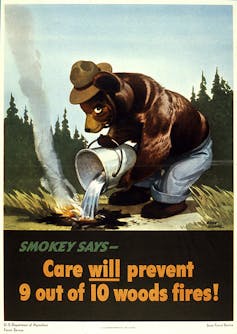Wildfire risks are high again this year – here's what travelers need to know
- Written by Ragan Adams, Coordinator, Veterinary Extension Specialist Group, Colorado State University
Memorial Day marks the traditional opening of the summer travel season. This year the American Automobile Association projects[1] that more than 41.5 million Americans will hit the road over Memorial Day weekend, nearly 5 percent more than last year and the most in a dozen years.
For many years, AAA has urged drivers to prepare for trips through steps such as testing their car batteries, checking for engine coolant leaks, and making sure their tires are in good shape. The group also recommends packing a mobile phone and car charger, a flashlight with extra batteries, a first-aid kit, a basic toolkit, and drinking water and snacks for all passengers.
But travelers should also think about conditions beyond their cars. As coordinator of Colorado State University’s Veterinary Extension programs, I help people in rural and urban communities manage all kinds of threats that can affect them and their animals, from disease to disasters. When people travel in unfamiliar places, far from their social safety nets, they should know what challenging conditions exist and prepare appropriately. In particular, anyone visiting the western United States this summer should understand risks associated with wildfires, since once again the risk of fires is high in many areas.
Thinking of lighting a campfire? Here are some quick tips on what you must consider before and after.Understanding fire conditions
The 2017 wildfire season was one of the most challenging years on record[2]. More than 71,000 wildfires burnt over 10 million acres. Federal agencies spent nearly US$3 billion on fire suppression, and 14 firefighters were killed in action.
This year the U.S. Forest Service expects another above-average fire season[3]. Many parts of the Southwest that depend on winter precipitation for moisture are dry. Coupled with above-average growth of grasses last year, conditions are ripe[4] to turn a harmless spark into flames. Wildland fire potential is forecast[5] to be above normal through August across portions of the Southwest, Great Basin, Southern California and the Pacific Northwest.
Wildland fires are fickle beasts that behave erratically, depending on wind speed and direction and the landscape over which they travel. If you are close to a fire, it can be difficult to tell which way the fire is moving. Firefighters, police and other first responders have access to information that defines the scope of a fire and the potential pattern of its movement. They use this information to define evacuation areas to keep people safe. It is essential to respect these boundaries.
Travelers in unfamiliar territory should research hazards they may face (including events such as blizzards, floods and tornadoes, as well as wildfires), and prepare accordingly. Here are some basic recommendations:
– Know where you are. GIS systems are convenient, but Siri may not always be available. Carry paper maps that you know how to read.
– Share your exact travel plans with friends or family. Inform them when you change course. Someone else should know where you think you are.
– Develop situational awareness. Pay attention to your environment: Seeing or smelling smoke is significant. Avoid rising rivers and flooded roads.
– Have a communication backup plan if cell service is not available. Sign up for reverse 911[6], subscribe to an emergency communications service such as Everbridge[7], or listen to AM channels advertised on road signs in rural communities.
– Check weather reports and respect red flag advisories.
– Respect warnings from local emergency managers and cooperate with first responders.
The human factor in wildfires
People trigger most wildfires in the United States. According to a 2017 study[8], 84 percent of wildfires federal and state agencies were called to fight between 1992 and 2012 were ignited by humans. Wildfires can also be ignited by lightning or sparks from railroads and power lines.
People start fires by discarding cigarettes carelessly, leaving campfires unattended or inadequately extinguished, and losing control of crop fires and prescribed burns. The 2017 study calculated that human actions have tripled the length[9] of the national wildfire season, extending it into spring, fall and winter.
The U.S. Forest Service has been educating Americans about their role in preventing wildfires since 1942, when Disney lent it images of Bambi the fawn and his forest friends for an educational poster. The campaign was very popular and confirmed that an animal was an effective fire prevention symbol. Because Bambi was only on loan, the agency had to find a new animal symbol. A majestic, powerful and appealing bear[10] fit the bill.
 Smokey the Bear’s first appearance on a fire prevention poster, 1944.
USFS[11]
Smokey the Bear’s first appearance on a fire prevention poster, 1944.
USFS[11]
The Smokey Bear Wildfire Prevention campaign[12], the longest-running public service advertising campaign in U.S. history, started in August 1944. The initial poster depicted a bear pouring a bucket of water on a campfire. In 2001, Smokey’s catchphrase was updated to “Only You Can Prevent Wildfires.”
Smokey’s message to prevent unwanted and unplanned outdoor fires is as relevant and urgent today as it was in 1944. By learning about campfire safety[13], safe management of backyard debris burns[14], and protecting houses and property from wildfire[15], Americans can make themselves safer, both on the road and at home.
References
- ^ projects (newsroom.aaa.com)
- ^ most challenging years on record (www.usda.gov)
- ^ another above-average fire season (www.predictiveservices.nifc.gov)
- ^ conditions are ripe (drought.unl.edu)
- ^ forecast (www.predictiveservices.nifc.gov)
- ^ reverse 911 (safetyinformed.org)
- ^ Everbridge (www.everbridge.com)
- ^ 2017 study (doi.org)
- ^ tripled the length (doi.org)
- ^ majestic, powerful and appealing bear (www.smokeybear.com)
- ^ USFS (www.smokeybear.com)
- ^ Smokey Bear Wildfire Prevention campaign (www.smokeybear.com)
- ^ campfire safety (www.smokeybear.com)
- ^ backyard debris burns (www.smokeybear.com)
- ^ protecting houses and property from wildfire (www.smokeybear.com)
Authors: Ragan Adams, Coordinator, Veterinary Extension Specialist Group, Colorado State University

